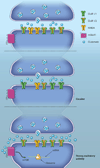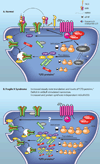Group 1 mGluR-dependent synaptic long-term depression: mechanisms and implications for circuitry and disease
- PMID: 20188650
- PMCID: PMC2841961
- DOI: 10.1016/j.neuron.2010.01.016
Group 1 mGluR-dependent synaptic long-term depression: mechanisms and implications for circuitry and disease
Abstract
Many excitatory synapses express Group 1, or Gq coupled, metabotropic glutamate receptors (Gp1 mGluRs) at the periphery of their postsynaptic density. Activation of Gp1 mGluRs typically occurs in response to strong activity and triggers long-term plasticity of synaptic transmission in many brain regions, including the neocortex, hippocampus, midbrain, striatum, and cerebellum. Here we focus on mGluR-induced long-term synaptic depression (LTD) and review the literature that implicates Gp1 mGluRs in the plasticity of behavior, learning, and memory. Moreover, recent studies investigating the molecular mechanisms of mGluR-LTD have discovered links to mental retardation, autism, Alzheimer's disease, Parkinson's disease, and drug addiction. We discuss how mGluRs lead to plasticity of neural circuits and how the understanding of the molecular mechanisms of mGluR plasticity provides insight into brain disease.
Figures




Similar articles
-
Mechanisms of synaptic depression triggered by metabotropic glutamate receptors.Cell Mol Life Sci. 2008 Sep;65(18):2913-23. doi: 10.1007/s00018-008-8263-3. Cell Mol Life Sci. 2008. PMID: 18712277 Free PMC article. Review.
-
Activation of synaptic group II metabotropic glutamate receptors induces long-term depression at GABAergic synapses in CNS neurons.J Neurosci. 2013 Oct 2;33(40):15964-77. doi: 10.1523/JNEUROSCI.0202-13.2013. J Neurosci. 2013. PMID: 24089501 Free PMC article.
-
Mechanisms Underlying Long-Term Synaptic Zinc Plasticity at Mouse Dorsal Cochlear Nucleus Glutamatergic Synapses.J Neurosci. 2020 Jun 24;40(26):4981-4996. doi: 10.1523/JNEUROSCI.0175-20.2020. Epub 2020 May 20. J Neurosci. 2020. PMID: 32434779 Free PMC article.
-
Do group I metabotropic glutamate receptors mediate LTD?Neurobiol Learn Mem. 2017 Feb;138:85-97. doi: 10.1016/j.nlm.2016.08.010. Epub 2016 Aug 18. Neurobiol Learn Mem. 2017. PMID: 27545442 Review.
-
Metabotropic glutamate receptor-mediated long-term depression: molecular mechanisms.Pharmacol Rev. 2009 Dec;61(4):395-412. doi: 10.1124/pr.109.001735. Epub 2009 Nov 19. Pharmacol Rev. 2009. PMID: 19926678 Free PMC article. Review.
Cited by
-
Developing BACE-1 inhibitors for FXS.Front Cell Neurosci. 2013 May 28;7:77. doi: 10.3389/fncel.2013.00077. eCollection 2013. Front Cell Neurosci. 2013. PMID: 23754978 Free PMC article.
-
RhoGTPases at the synapse: An embarrassment of choice.Small GTPases. 2017 Apr 3;8(2):106-113. doi: 10.1080/21541248.2016.1206352. Epub 2016 Aug 5. Small GTPases. 2017. PMID: 27492682 Free PMC article. Review.
-
Using metabotropic glutamate receptors to modulate cocaine's synaptic and behavioral effects: mGluR1 finds a niche.Curr Opin Neurobiol. 2013 Aug;23(4):500-6. doi: 10.1016/j.conb.2013.01.009. Epub 2013 Feb 4. Curr Opin Neurobiol. 2013. PMID: 23385114 Free PMC article. Review.
-
Phencyclidine Disrupts Neural Coordination and Cognitive Control by Dysregulating Translation.Biol Psychiatry Glob Open Sci. 2023 May 31;4(1):252-263. doi: 10.1016/j.bpsgos.2023.04.009. eCollection 2024 Jan. Biol Psychiatry Glob Open Sci. 2023. PMID: 38298788 Free PMC article.
-
Carbachol-induced long-term synaptic depression is enhanced during senescence at hippocampal CA3-CA1 synapses.J Neurophysiol. 2010 Aug;104(2):607-16. doi: 10.1152/jn.00278.2010. Epub 2010 May 26. J Neurophysiol. 2010. PMID: 20505129 Free PMC article.
References
-
- Airan RD, Thompson KR, Fenno LE, Bernstein H, Deisseroth K. Temporally precise in vivo control of intracellular signalling. Nature. 2009;458:1025–1029. - PubMed
-
- Anwyl R. Metabotropic glutamate receptors: electrophysiological properties and role in plasticity. Brain Res Brain Res Rev. 1999;29:83–120. - PubMed
Publication types
MeSH terms
Substances
Grants and funding
LinkOut - more resources
Full Text Sources
Other Literature Sources

